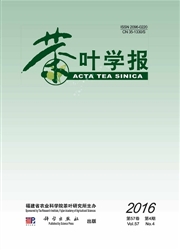

 中文摘要:
中文摘要:
利用核磁共振波谱技术检测铁观音茶汤的水浸出物,研究水浸出物随冲泡次数的变化规律,并结合多变量统计方法,研究浓香型和清香型铁观音茶叶的水浸出物在组成模式上的差异。实验结果表明:茶汤中水浸出物的浸出量随冲泡次数快速下降,大部分水浸出物在第5道茶汤中的浸出量已不足10%;不同道茶汤中水浸出物的组成模式存在明显差异,从而导致各道茶汤在口感上的迥异;此外,浓香型和清香型茶汤中水浸出物的组成模式也存在显著差异:与清香型茶汤相比,浓香型茶汤中的表儿茶素、蔗糖等物质的相对含量较高,而茶氨酸、异亮氨酸、表儿茶素没食子酸酯、奎尼酸、表没食子儿茶素、表没食子儿茶素没食子酸酯等物质的相对含量较低。
 英文摘要:
英文摘要:
Nuclear magnetic resonance spectroscopy was applied to obtain metabolic fingerprints of the water extracts of Tie guanyin teas. By using the multivariate statistical analysis on the data obtained on the extracts from consecutive steeping, the compositional differences between the lightly and strongly fragrant varieties of the tea were compared. Overall, the concentrations of the elements in the extracts decreased with increasing number of steeping. On the 5th tea brewing, the concentrations became less than 10% of the initial amount, which invariably changed the sensory quality of the tea. There were significant differences in the chemical make ups between the lightly and strongly fragrant varieties of the tea. The strongly fragrant variety tended to have a significantly higher contents of sucrose and epicatechin, but lower of theanine, epicatechingallate, quinate, isoleucine, and epigallocatechin/epigallocatechingallate than its lightly fragrant counterpart.
 同期刊论文项目
同期刊论文项目
 同项目期刊论文
同项目期刊论文
 (1) H NMR Metabolic Profiling of Biofluids from Rats with Gastric Mucosal Lesion and Electroacupunct
(1) H NMR Metabolic Profiling of Biofluids from Rats with Gastric Mucosal Lesion and Electroacupunct 期刊信息
期刊信息
